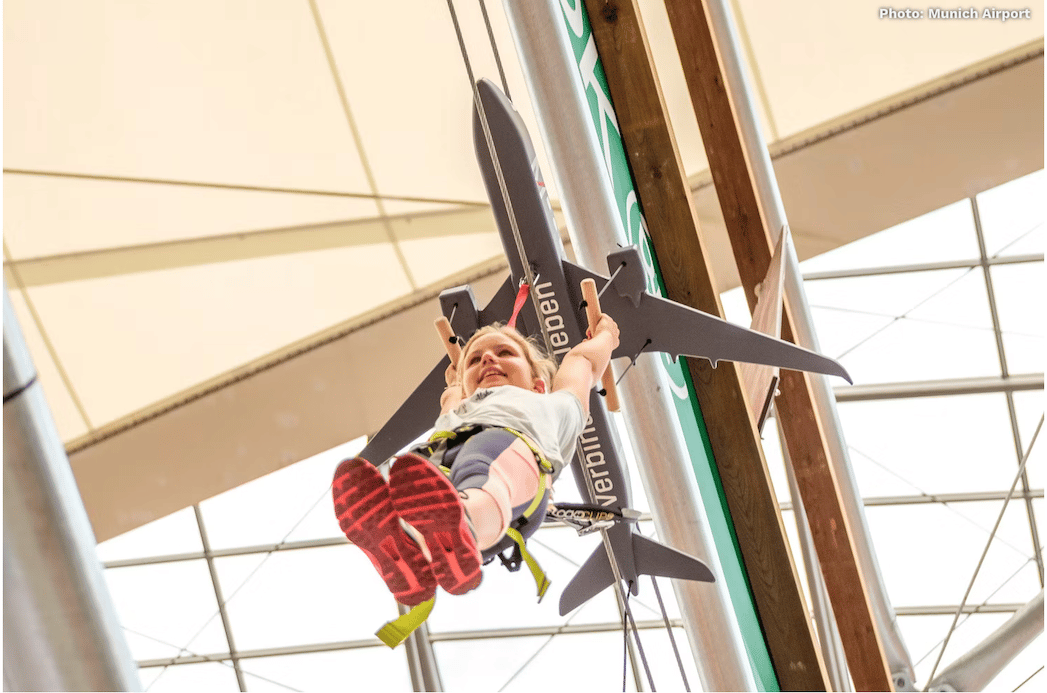
Flying High. Recently the Munich Airport opened a high rope climbing course that reaches a height of 45 ft (15 meters.) Located between Terminals 1 and 2, the amusement center allows visitors, who pay a modest price of $5.12, to walk on aerial suspension bridges, climb rope ladders and fly solo like the child depicted above under the watchful eye of skilled supervisors. Photo by Munich Airport
By Lauren Nelson
While no one’s ideal afternoon is spent in an airport, modern innovation funded by pandemic-inspired government investment is transforming the stereotypical airport experience. Fairly recent advancements in technology and modern architectural design offer passengers a more relaxed, enjoyable, and efficient experience.
Many consider the Trans World Fight Center at John F. Kennedy Airport to have set the standard of modern airport design. In 1962, the terminal opened with a futuristic stylization. The architect, Eero Saarinen, aimed to “express the excitement of flight” through the airport’s design. As a result, the building resembles an enormous albatross with two giant wings serving as the roof.
The TWA terminal closed in 2001 after American Airlines could no longer afford operations. It remained closed for almost 20 years until it reopened as the TWA Hotel in 2019. Today, the wing-shaped roof remains intact and the interior of the hotel, designed by Lubrano Ciavarra Architects, takes after the original terminal. The hotel transports guests to the Jet Age allowing them to experience the history of the terminal. The iconic roof design, red carpets, Saarinen-designed chairs, and large windows which fill the building with natural light serve as inspiration for airport modernization.
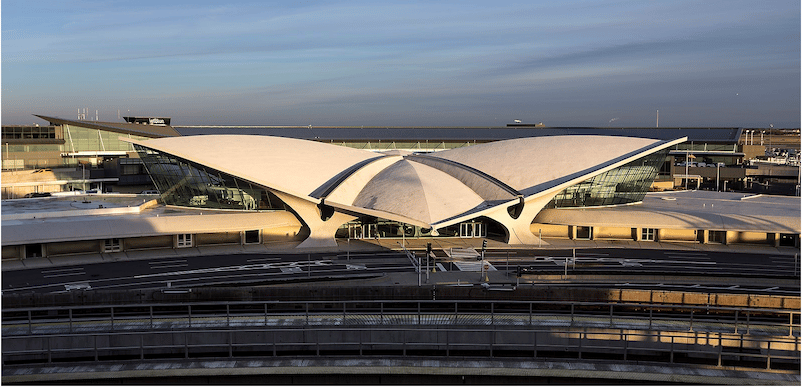
The TWA Flight Center at New York’s JFK Airport by Finnish-American architect Eero Saarinen is widely considered to be the world’s best-designed terminal. Saarinen also designed Dulles International Airport and the Gateway Arch in St. Louis.
Modernization Aims to Reduce Stress
Modern trends in airport architecture and design focus on the passenger experience more than ever before. The pandemic motivated airport designers and developers to prioritize passengers’ mental and physical health. Travel Weekly’s senior editor for aviation, Robert Silk, explains how the incorporation of outdoor spaces, lounge seating, and even the location of dining spaces benefit passengers. “These features create a more comfortable environment that reduces the stress of traveling,” says Silk.
The Denver International Airport’s $2.3 billion expansion includes multiple outdoor spaces, one of which is already complete. On the airport’s far western end of Concourse B is an outdoor deck where passengers can enjoy mountainous views from comfortable seating around fire pits. Similar spaces are soon to come at the Pittsburgh International Airport, LaGuardia Airport, John F. Kennedy International Airport, Los Angeles International Airport, and Chicago O’Hare International Airport according to their expansion plans. Overseas, the Berlin Brandenburg Airport and the Hong Kong International Airport already offer outdoor spaces and lounge seating.
Comfortable seating is increasing indoors as well. It ranges from the leather chairs at the gates of Washington’s Reagan National Airport to the cushion recliners in the Snooze Lounge of every terminal in Singapore’s Changi Airport. These features allow passengers to wait for their fights comfortably and help reduce travel anxiety.
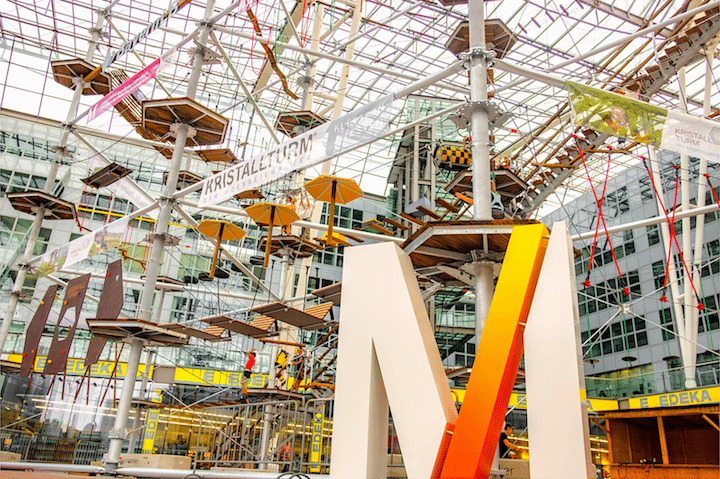
Opened in August 2022, the Munich Airport high rope course allows travelers looking for fun to soar across a structure 23 meters wide while their less adventurous friends drink cocktails at the adjoining Sausalito Airport Bar.
Concession areas are also evolving to create a more relaxed customer experience. In the past, the majority of dining options were located after security before the boarding area. While those options still remain, it has become increasingly common for additional concessions to be placed along terminal concourses. The Reagan National Airport and Newark Liberty International Airport both added concessions in close proximity to gates with seating that faces the boarding areas. This way passengers can keep an eye on their gate while they dine to ensure they don’t miss their fight.
Some aesthetically pleasing design elements can actually reduce stress as well. These include high ceilings to create less confining spaces, tons of greenery, and large windows and skylights to optimize natural light. All of these are popular design trends in airport modernization and are a part of most terminal development, redevelopment, or expansion projects.
But What About Efficacy?
While the features mentioned above help reduce travel anxiety and improve relaxation they are not necessarily increasing the functionality of airports. CBS travel editor, Peter Greenberg says that efficiency should be considered the most crucial aspect of airport modernization. “The purpose of an airport is to get passengers to their destination as quickly as possible,” says Greenberg. Technological advancements are the key to improving airports’ efficacy.
Self-service kiosks have, for a while now, improved airport efficiency by enabling passengers to check in for their flight, print their boarding pass, and tag their checked luggage in just a few minutes. This prevents long lines at the check-in point because passengers no longer have to wait for staff to perform these tasks.
The development of virtual security queuing technology is working to eliminate long lines at airport security too. This technology offers passengers a designated time to go through the security checkpoint. It either assigns passengers a time after they check in or allows them to select a time before arrival. The system staggers the flow of passengers to reduce lines which improves the efficiency of security. It was implemented in Terminals 7 and 8 at the Los Angeles International Airport and at TSA checkpoints 2 and 5 of the Seattle-Tacoma International Airport during the pandemic. While passengers still have to wait for their turn, this technology allows them to spend that time however they please rather than standing in line.
The Abu Dhabi International Airport is optimizing virtual queuing technology through its ‘Smart Travel’ system. The system was put into trial in 2021 to facilitate social distancing and is still in use today. Powered by artificial intelligence, it uses data on passenger traffic to inform passengers of the best time to arrive at the airport. This prevents overcrowding and shortens the time passengers wait in the queue.
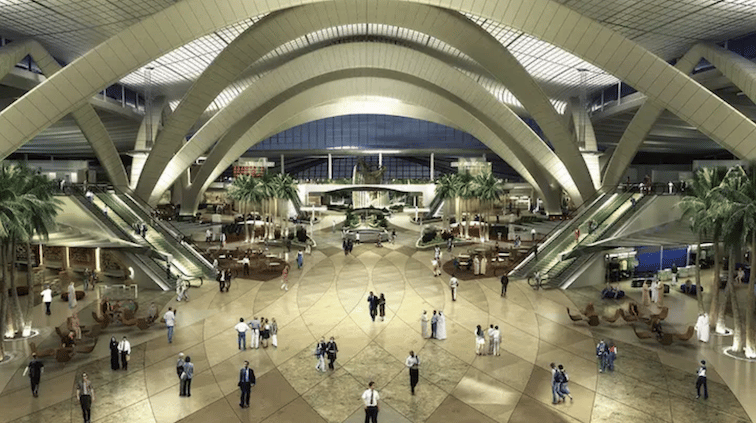
When complete, Abu Dhabi’s Midfield Terminal will be the world’s largest airport
Biometric facial recognition is furthering the touchless experience at the airport and improving both efficacy and security. For the past few years, British Airways has applied this technology at Heathrow Airport in London to improve security. The system captures two pictures of passengers; one at security and one at the boarding gate. It then compares the images to each other and with the passengers’ flight information to ensure their identity before they are allowed to board the aircraft.
In the U.S., Delta Airlines at Hartsfield-Jackson Atlanta International Airport gives passengers the option to use biometric facial recognition technology to check bags, clear security, and board their flight. First, passengers must opt-in by entering their U.S. passport number into the system to verify their identity. After allowing the technology to scan their face to receive their baggage tags, passengers head to a TSA Pre-check line for another facial scan to move through security. At the gate, their face is scanned one last time before they board. Passengers that register with the facial recognition technology don’t need any physical identification and save time through the express TSA Pre-check.
As of July 2022, U.S. Customs and Border Protection implemented facial recognition technology in all U.S. airports for passengers entering the country and just 32 of the nation’s airports for those leaving the country. There is controversy around this technology due to privacy concerns. However, the U.S. Government Accountability Office is pushing the CBP to take necessary steps to ensure privacy and inform passengers. For instance, airlines are prohibited from storing passengers’ photos for their own use and privacy signage with information like how to opt-out of facial recognition screenings is required.
More to Efficacy Than Technology
Innovative architecture like intuitive wayfinding designs are also making airports more functional. This technique helps passengers instinctively navigate their way through the airport. For instance, the ceiling of London’s Heathrow Airport is designed to resemble waves that are intended to be a guide. Passengers meet the first wave at the check-in area, the next one moves them through security, and the last wave leads them past the retail and dining spaces to the gates. Pittsburgh International Airport’s expansion plans include a similar wayfinding design. There, the ceiling will resemble hills and valleys inspired by the city’s terrain. Gathering areas, like check-in and security, will be located under the hills. The higher ceiling and wide open space is supposed to help passengers instinctively locate these points. The valleys of the ceiling will be lower which should help passengers perceive these areas as transitioning spaces between the gathering areas.
Most importantly, airports are being designed for the future, says Silk. Since technology is constantly evolving, developers are “focused on building airport facilities that are prepared to adapt to future innovations,” he says. For instance, designers and developers are taking things such as electrical wiring into consideration during construction in order to optimize an airport’s technological capacity. The purpose of this is to build an airport to be as compatible as possible with the technological advancements that are to come.
Funding the Future of Modernization
The U.S. government has provided a substantial amount of funds to support the expansion or redevelopment of airports across the country. The 2021 infrastructure bill includes $5 billion to upgrade airport terminals and $15 billion to improve runways, safety, and sustainability. The Federal Aviation Administration (FAA) recently awarded 85 airports across the nation with the first round of grant money which was $969 million in total. A few of the recipients awarded to expand terminal capacity or increase terminal sustainability include the Pittsburgh International Airport, Orlando International Airport, Dallas-Fort Worth International Airport, and Seattle-Tacoma International Airport.
Typically, passenger facility fees are used to fund terminal projects. The federal government capped this fee at $4.50 per flight segment, but the Airport Council International has wanted to increase it for years. The council argues that the funding from the infrastructure bill is not nearly enough to satisfy the cost of airport expansion, which they have estimated to be $115.4 billion through 2025. “There are additional sources of funding and there can always be more and that conversation will continue,” says U.S. Secretary of Transportation, Pete Buttigieg. “But what we’re looking at right now is the most we’ve been able to do in a very long time.”
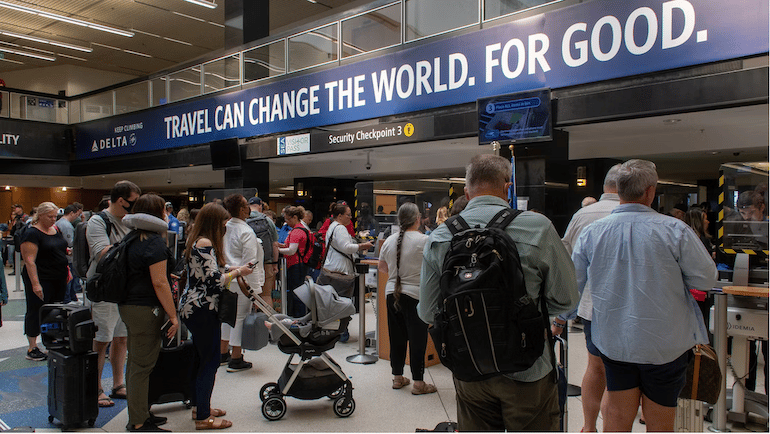
Increased computer scanning and biometrics may make airport security less stressful in the future. Photo by Joe Kunzler, Simple Flying
The Point of Modernization
Modern trends in airport design aim to improve the airport experience for all parties. Features like outdoor spaces, lounge seating and strategically placed dining spaces reduce the stress of traveling. Wayfinding designs make airport navigation easier. Most importantly, technological advancements reduce wait times and improve efficacy and safety. Modern improvements like these not only make the airport a better place to spend time, but they reduce the time passengers have to spend there.
Lauren Nelson is a journalism student at the University of Texas at Austin, who has gained experience through her work with the Daily Texan. Her previous story for EWNS explored 21st Century park design.

